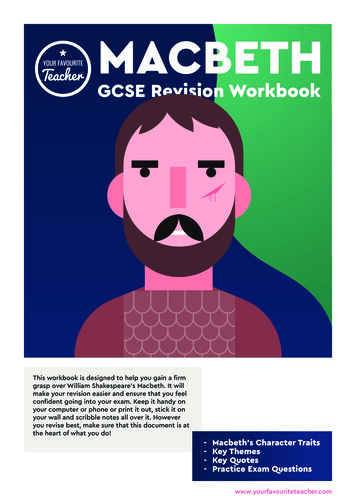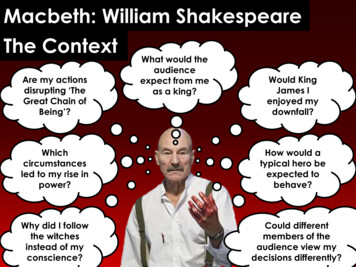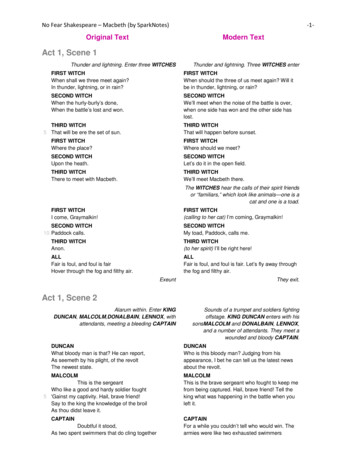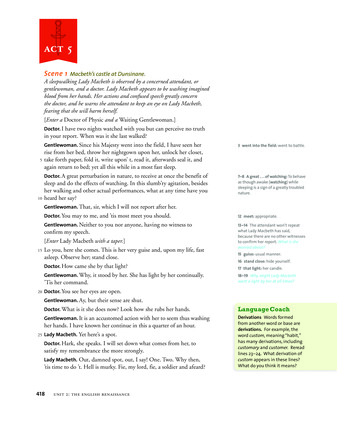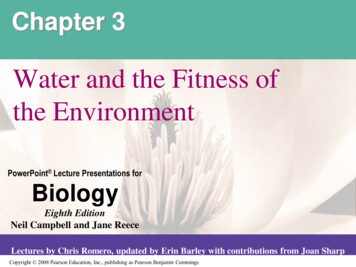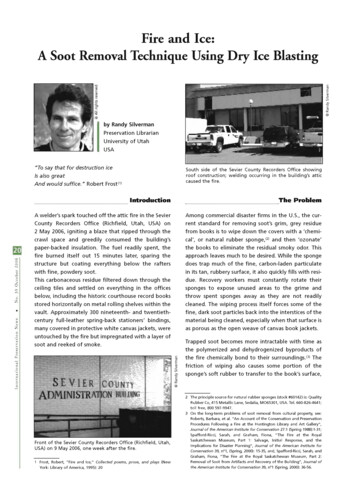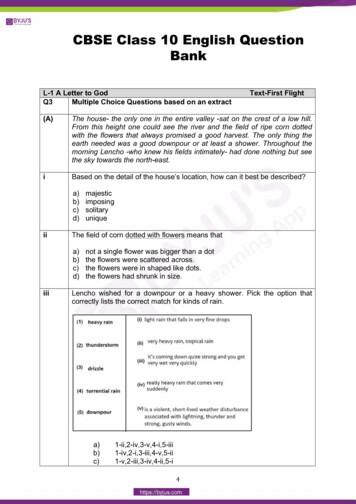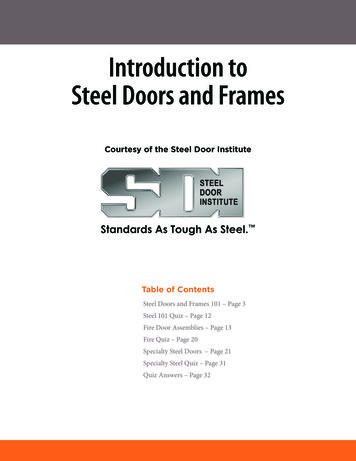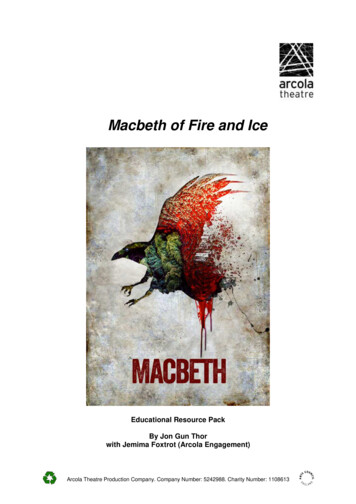
Transcription
Macbeth of Fire and IceEducational Resource PackBy Jon Gun Thorwith Jemima Foxtrot (Arcola Engagement)Arcola Theatre Production Company. Company Number: 5242988. Charity Number: 1108613
ContentsAbout this educational pack and how to use it.Part 1: The PlayMacbethPlot SynopsisMajor themes and areas for discussionPart 2: Areas of studyA background of Norse mythologyThe Weird Sisters and the Norns.Lady MacbethSymbols in MacbethPart 3: Activities and exercisesResponding to the productionGeneral activities and exercisesPart 4: Macbeth of Fire and IceProduction elements.Writing a critical reviewPart 5: Additional MaterialLandscape in Macbeth of Fire and Ice and Ragnar’s PhotographsFurther resourcesCast and crew detailsArcola Theatre Production Company. Company Number: 5242988. Charity Number: 1108613
About this educational pack and how to use itThis educational pack has been designed as an aid for teachers and students foruse when studying Macbeth and especially in response to this production Macbeth ofFire and Ice.Part 1 provides a historical context of Macbeth, a simple plot synopsis, andsummarises some of the play’s main themes. This can be used as a starting point forstudents and teachers.Part 2 focuses on three main areas: the Weird Sisters, Lady Macbeth and symbolsin the play. It also looks at the connection between Macbeth and Norse mythology.This section includes study questions and practical exercises which can be usedeither before the students see the production or to reflect afterwards.Part 3 contains some more general study questions and exercises that tackle theplay as a whole; again, these materials can be used either before or after thestudents see the production.Part 4 is for use after students have seen the production. It asks study questionsabout several elements of the production and then asks students to write a criticalreview of it. This is a useful tool for students to learn evaluation skills from a specificproduction.Part 5 contains an additional exercise which asks students to respond tophotographs presented in an exhibition alongside the production. This section alsoprovides suggestions for further resources and information about the cast and crew.Headings in RED indicate study or discussion questionsHeadings in BLUE indicate practical exercisesArcola Theatre Production Company. Company Number: 5242988. Charity Number: 1108613
Part 1: The PlayMacbethMacbeth is believed to have been written between 1603 and 1607 and is mostcommonly dated as written in 1606. It is considered to be one of Shakespeare’sdarkest and most powerful tragedies. Originally set in Scotland, Macbeth tells a taleof how boundless ambition can have disastrous effects.Shakespeare's primary source for Macbeth was Raphael Holinshed's Chronicles ofEngland, Scotland and Ireland, first published in 1577. The outlines ofShakespeare's story are derived from Holinshed's account of Kings Duncan andMacbeth. In addition, Shakespeare seems to have taken many particulars fromHolinshed's account of King Duffe, who died eighty years before Macbeth did.Holinshed’s Macbeth takes place in the 10th century and is influenced by one of theIcelandic Sagas; Orkneyinga Saga which was written around 1230 by an unknownIcelandic author. The Orkneyinga Saga is also known as The History of the Earls ofOrkney and is a historical narrative of the history of the Orkney Islands from theircapture by the Norwegian king in the ninth century onwards until about 1200.Plot synopsisThe play opens as three Weird Sisters plan a meeting with the Scottish noblemanMacbeth, who at that moment is fighting in a great battle. When the battle is over,Macbeth and his friend Banquo come across the witches who offer them threepredictions: that Macbeth will become Thane of Cawdor and King of Scotland, andthat Banquo's descendants will become kings.Banquo laughs at the prophecies but Macbeth is excited. Macbeth’s excitement isheightened as soon after their meeting with the witches Macbeth is made Thane ofCawdor by King Duncan, in return for his bravery in the battle. He writes to his wife,Lady Macbeth, who shares his excitment, but is even more ambitious. A messengertells Lady Macbeth that King Duncan is on his way to their castle and she invokesevil spirits to help her slay him. Lady Macbeth persuades Macbeth to kill Duncanwhich he does by stabbing him to death. Macbeth is crowned king.Macbeth now begins to fear the third prediction that Banquo's descendants will alsobe kings will also come true. He therefore decides to have Banquo and his son killed,but the plan goes wrong - Banquo is killed but his son escapes. Macbeth then thinkshe is going mad because he sees Banquo's ghost at his banquet. He then receivesyet more predictions from the witches which seem so inconcievable that he believeshe will never lose his position of power. He starts to become ruthless and kills thefamily of Macduff who is an important lord. Macbeth still thinks he is safe but one byone the witches' prophecies come true. Lady Macbeth cannot stop thinking aboutDuncan, becomes deranged and dies. A large army marches on Macbeth's castleand Macbeth is killed by Macduff. Macduff hails Malcolm as King of Scotland andArcola Theatre Production Company. Company Number: 5242988. Charity Number: 1108613
Malcolm makes the final speech of the play; he thanks everybody and promises thatall of his thanes will be rewarded by becoming earls.Macbeth of Fire and Ice – The ProductionMacbeth of Fire and Ice is a modern and dynamic telling of the story of Macbethinfluenced by Norse mythology. Icelandic Director Jon Gun Thor draws on hiscountry’s culture and history to influence and shape this production. The raw brutalityof the Vikings, the powers of the Valkyries, the mystic forest, the Nordic lights, thesounds of volcanic eruptions and hot springs all paint the picture of Macbeth of Fireand Ice.Major themes and areas for discussionMajor themes in Macbeth include:Ambition: Macbeth’s ruthless search for power, encouraged by Lady Macbeth,is what fuels the action and causes his downfall.Evil: the urge to destroy whatever is good; the brooding presence ofmurderous intent and action.Order and disorder: the struggle to maintain or destroy social and naturalbonds and the destruction of morality.Appearance versus reality: deciet and hypocrisy mean that appearances cannot be trusted.Violence and tyranny: warfare, destruction and oppresion occur throughout.The play also explores the response of Macbeth’s subjects the escalatingviolence and how ambition can transform into tyranny.Guilt and conscience: Macbeth and Lady Macbeth both know that murder iswrong but does it nonetheless and suffers agonies of conscience as a result.Gender: Lady Macbeth shows ruthless traits that are typically consideredmasculine, rather than typically feminie traits of loving and caring. There is aconstant pressure on the men in the play to fulfil roles of masculinity. Therecould also be gender confusion about the Weird Sisters.Arcola Theatre Production Company. Company Number: 5242988. Charity Number: 1108613
Part 2: Areas of studyA background of Norse mythologyNorse mythology, or Scandinavian mythology, is the body of mythology of the NorthGermanic people stemming from Norse paganism and continuing after thechristianisation of Scandinavia and into the Scandinavian folklore of the modernperiod.The following is an extract from the first and best known poem of the Poetic Edda.The Poetic Edda is a collection of Old Norse poems primarily preserved in the CodexRegius. The author of the Poetic Edda is unknown. This extract can be read asbackground to Macbeth and several similarities can be drawn between the role of thethree maidens of the poem and the three Weird Sisters of Macbeth.Völuspá.I know an ash stands,named Yggdrasill,a high tree, washedwith white clay;from it come the dewsthat fall in the valleys,it stands ever grennover Spring of the Past.From there come the much knowing maidens,three from the seathat lies under the tree:one was named Past,another present-they carved in woodand Future the thid;Arcola Theatre Production Company. Company Number: 5242988. Charity Number: 1108613
they laid down the law,they choose livesfrom the children of menpeople s fates.Study QuestionsCan you identify what the the three maidens in Völuspá have in common withthe three Weird Sisters in Macbeth?Write your own poem which describes your own invented version of the WeirdSisters of Macbeth or the three maidens of this poem. Think about what theymight look like, how they might speak and the effect their fortune tellingabilities might have on the people around them.Practical ExercisesWorking in threes come up with at least three ideas about how to solve theproblem of the stage direction Witches vanish (Act I, Scene III), think aboutwhat might be most visually effective for the audience. Choose one of theideas to develop, rehearse and present to the class.In groups of three or more look at Act IV, Scene I and come up with aninventive way of presenting the three apparitions – an armed head, a bloodychild and a child crowned with a tree in his hand. Be as inventive as you likeand think about using moment, sound and any available props. Rehearse andpresent to the class.The Weird Sisters and the Norns.There are many parallels between the Norns of Norse mythology and the WeirdSisters of Macbeth.The NornsThe Norns were three sisters who were the Northern goddesses of fate. According tosome mythologists, their purpose in coming to us was to warn the gods of future evil,to bid them make good use of the present, and to teach them wholesome lessonsfrom the past.These three sisters were personifications of the past, present, and future. TheseNorns were daily visited by the gods, who loved to ask them questions about theirfate.Arcola Theatre Production Company. Company Number: 5242988. Charity Number: 1108613
The Weird SistersThe Three Witches or Weird Sisters are characters in William Shakespeare's playMacbeth. They are never refered to as witches in the play.The three Weird Sisters first appear in Act I, Scene I where they agree to meet laterwith Macbeth. In Act I, Scene III, they greet Macbeth with a prophecy that he shall beking, and his companion, Banquo, with a prophecy that he shall generate a line ofkings. The prophecies have great impact upon Macbeth. As the audience laterlearns, he has considered usurping the throne of Scotland. The Weird Sisters nextappear in what is generally accepted to be a non-Shakespearean scene, Act III,Scene V, where they are reprimanded by Hecate for dealing with Macbeth withouther participation. Hecate orders the trio to congregate at a forbidding place whereMacbeth will seek their art. In Act IV, Scene I the Weird Sisters gather as Hecateordered and produce a series of ominous visions for Macbeth that herald hisdownfall. The meeting ends with a show of Banquo and his royal descendants. TheWeird Sisters then vanish.Study QuestionsUsing the above descriptions of the role of the Norns in Norse mythology andthe role of the Weird Sisters in Macbeth, write a list of the similarities betweenthem.How do Banquo and Macbeth react when they first encounter the weirdsisters in Act I, Scene III? Are they surprised, afraid, confused?The sisters accurately predict Macbeth's future, but do they actively control hisfate? Why or why not?Are there connections or similarities between the weird sisters and any othercharacters in the play? If so, what are they?Who do the weird sisters represent today?Practical ExercisesIn groups of three look at Act I, Scene I and develop and rehearse how youmight present the scene for a radio play. Of course, with a radio play, theaudience cannot see anything. The witches’ tone of voice is thereforeessential, it is particularly important for the audience to be able to differentiatebetween each witch by their voices alone. Don’t forget to think about soundeffects, the listener must understand the setting is a wild and windy heath, nota cosy living room! Perform to the rest of the class. It may be useful to ask theaudience to shut their eyes.In groups of three look at Act I, Scene I and develop and rehearse how youmight present the scene as a mime, in complete silence. It is important tothink about movement in terms of character as well as to convey the meaningand action of the scene.You may want to have half the class work on the radio play version of thescene while the other half develops the mime version. The students can thendiscuss and evaluate the scenes.Arcola Theatre Production Company. Company Number: 5242988. Charity Number: 1108613
Lady MacbethLady Macbeth is a powerful presence in the play. There is conflict between femininityand masculinity in Lady Macbeth’s character, she suppresses her instincts towardcompassion, motherhood, and fragility — associated with femininity — in favour ofambition, ruthlessness, and the singleminded pursuit of power traits which areassociated with masculinity.Lady Macbeth’s masculine behaviour makes her similar to the Weird Sisters who arealso depicted as defeminised, androgynous figures. In Act I, Scene III Banquo saysof the witches “You should be women/ And yet your beards forbid me tointerpret/That you are so”Study Questions What does Lady Macbeth have in common with the Weird Sisters? Useexamples from the text to support your answers.Discuss why, in this production, the actor who plays Lady Macbeth also playsone of the Weird Sisters.Using examples from the text, can you identify ways in which Lady Macbethand the Weird Sisters challenge typical gender roles?Practical ExercisesLady Macbeth takes an active, masculine role while Macbeth becomespassive; no longer the valiant soldier but the doubting accomplice, subject toLady Macbeth’s demands that he go through with the dark plot. In pairs lookat Act I, Sc V and each choose a character: either Macbeth or Lady Macbeth.Read the scene through and then, in character, ask each other the followingquestions- Who are you?- What are you doing?- Where have you just come from?- What do you want in this scene?- What do you want in the whole play?- Use five adjectives to describe how you feel.If you are struggling to find the answers to these questions, return to the thetext.Something stops Lady Macbeth from killing Duncan herself: ‘Had he notresembled/ My father as he slept, I had done’t’ (Act II, Scene II). Workingalone, use these lines to inspire a short monologue based on one of thefollowing:- The childhood of Lady Macbeth: told by herself- The childhood of Lady Macbeth: told by her father- Lady Macbeth and the sleeping DuncanArcola Theatre Production Company. Company Number: 5242988. Charity Number: 1108613
Symbols in MacbethThe Raven: In Shakespeare’s time, and indeed to some extent today, the raven wasassociated with death and doom. Shakespeare actually referes to the raven acrossall his works more than he does to any other bird. In Act I, Scene V Lady Macbethsays “The raven himself is hoarse/That croaks the fatal entrance of Duncan”The Owl: In Shakespeare’s time, the cry of a screech owl was thoughto to announcedeath. In Act II, Scene II, Lady Macbeth refers to the owl as a “fatal bellman/Whichgives the stern’st good-night”Blood:Once Macbeth and Lady Macbeth embark upon their murderous journey,blood comes to symbolize their guilt, and they begin to feel that their crimes havestained them.The Weather: From the thunder and lightning that accompany the WeirdSisters to the terrible storms that rage on the night of Duncan’s murder,weather is symbolic of corruption in the moral and political orders.Study QuestionsIt is interesting to note the differnces in various symbols’ meanings in Norsemythology and in Macbeth. Using the internet, research and write down threethings that the following things symbolise, first in Macbeth, then in Norsemythology.Raven, owl, sleep, tree, blood and weather.Can you think of any other symbols that feature in Macbeth? Using theinternet, research whether these symbols also feature in Norse mythologyand, if so, what they represent.Can you think of any symbols used today in modern literature, on thetelevision, in films or on the internet? What are these symbols and what dothey represent?Practical Exercises In small groups, choose one of the symbols from Macbeth – it could be oneidentified already or one of your own and create two still images with yourbodies. One image should be a portrayal of the symbol (for example, blood)and the other should be a portrayal of what that symbol represents (in thisinstance, guilt). Share with the rest of the class who will then try to identifywhich symbols are being portrayed.Arcola Theatre Production Company. Company Number: 5242988. Charity Number: 1108613
Part 3: General activities and exercisesStudy QuestionsResponding to the productionAfter the production, consider these questions.Did you empathise with any of the characters? Who and why?Did you sympathise with any of the characters? Who and why?Was there a message, a moral, or anything to be learnt from the action of theplay and if so, what was it?Can you think of five ways this production was successful in conveying theplay’s message?Macbeth asks many ethical and moral questions including:Are you a murderer if you ask somebody else to kill for you?Does power corrupt?Can ambition lead to evil?Try to answer these questions with reference to the play and then try to identify atleast three more moral questions that Macbeth asks us to consider.Practical ExercisesIn small groups identify scenes which are set inside and which are setoutside, which are in light and which in darkness. The scenes on the heathshould be performed very differently from the scenes in the castle. Scenesthat takes place in daylight are different than senses in the darkness. A senseof environment is extremely important so try rehearsing Act III, scene Voutside or perhaps even try rehearsing Act II, scene II in the dark! Take noteof and discuss how a change of environment effects how you speak andmove.In small groups place a bunch of keys somewhere on the floor and blindfoldone actor. The actor must walk towards the keys and pick them up without asound, if they make any noise at all, they must start again. The aim of this isto try to recreate the way Macbeth may have been feeling when he killedDuncan. When Macbeth stabs Duncan, it is in complete darkness, everyone isfast asleep, if someone wakes up, then Macbeth will be discovered andpossibly killed himself. So he must murder Duncan silently. Try to make surethat everybody has a chance to be blindfolded and then discuss how thismade you feel. Nervous? Tense? Scared? This should help you understandhow Macbeth feels in Act II, Scene II after he has murdered Duncan.In groups of 4 – 6 rehearse and perform a three minute version of the play,think about what the key events of the action are. Afterwards discuss why youchose certain moments and characters to feature in your condensed versionas well as why you chose to leave certain characters/moments out.Arcola Theatre Production Company. Company Number: 5242988. Charity Number: 1108613
In Pairs decide on one character each and choose no more that five linesfrom the play that describe your character. These lines can be spoken by yourcharacter itself or may be spoken a different character referring to your own.Once you have chosen these lines take turns to perform them to your partner.Now try performing these lines to your partner without saying the actualwords, just making noises or speaking nonsense instead. Does theexpression in your voice allow your partner to understand your character’snature? How can you make them understand it better? Perhaps you couldinclude physical movements to make your character clearer.Working alone, choose a speech from Macbeth and then follow Jon GunThor’s direction to ensure that you invest it with character and feeling. First ofall, ensure you know the meaning of the text. If there are words you don’tunderstand, look them up until you understand the meaning of the wholespeech. Then find the exclamation marks and question marks: these may notalways be actually marked in the text but where you think the character isexcited or passionate or angry about something, use an exclamation mark. Ifthe character is asking a question, make sure you make this very clear, reallyask the question.Look at the punctuation, the full stops and the commas. After each full stopthere should be a breath/pause for three beats and after each comma thereshould be a breath/pause for just one beat which often means that thefollowing text should be a continuation of the same thought. Find theparentheses or the brackets in the speech. What is of primary importance andwhat can be bracketed off? How do you say things of lesser importance?All of these exercises should help you to add expression into the speech.Once you have identified all of these points, you should have a betterunderstanding of the rhythm and meaning of the speech. Now try to forgetthese intricacies and perform the speech naturally. Many people say that if Shakespeare were alive now, he would be writing forsoap operas. In small groups devise a 5 minute, modern day version ofMacbeth in the style of a soap opera. Rehearse and share with the class.Arcola Theatre Production Company. Company Number: 5242988. Charity Number: 1108613
Part 4: Macbeth of Fire and IceThe director’s background and approachJon Gun Thor is Icelandic and draws upon his cultural background in his approach.He studied directing at Drama Centre London between 2003 and 2006 and duringthis time was privileged to study under Di Trevis (who was the first female director towork at the National Theatre).He has written and directed twelve plays and directed many more includingmusicals, physical theatre, new writing and an opera.A Note from Jon Gun Thor:“To direct Shakespeare is very challenging and you have to understand the textbefore you enter the rehearsal room. How could you direct the actors if youdon’t know the meaning of the text yourself?Because English is not my first language, I use both an English Shakespeareanscript and an Icelandic translation. Often it is better and easier just to read thetext in English but it’s nice to refer to the text in your native language. In sometranslations the translator has too much respect for Shakespeare and theymake the text seem even older and more difficult than it is, this just makesShakespeare boring. When I studied Macbeth I used a very good book calledNCS; the new Cambridge Shakespeare, edited by A. B. Braunmuller. That bookis an excellent translation. There is an explanation on almost every word, and Ialso look up almost every word. When I know the meaning behind every singleword, this starts to be fun. Directing becomes like a puzzle or the Da Vincicode.I wouldn’t start my direction by deciding on how or where I set it up; as aSecond World War production of Macbeth, African Macbeth, Macbeth in thespace or Macbeth based on Northern Myths - UNTIL, I have done myhomework and know the meaning of the play. The text should guide how youapproach the production.But the good and exciting thing with Shakespearean text is that you are alwaysfinding more and more out. And you never know it all but work makes youconfident.”There are many different ways to approach a powerful Shakespearian text suchas Macbeth: due to his cultural background, this Jon Gun Thor has chosen tointerpret the play with the assistance of Norse mythology.”Arcola Theatre Production Company. Company Number: 5242988. Charity Number: 1108613
Production ElementsThe CastThe cast are the group of actors who perform in the production. This cast is made upof an ensemble of 6 artists, dancers and singers. In this production, it is importantthat the actors have many inter-disciplinary skills. Every cast member, except theactor playing Macbeth, plays another role in the story.A Note from Jon Gun Thor:“When I enter the rehearsal I have to be fully confident, I know what I want toaim at, but I also have to be open minded. I direct my actors by askingquestions; Who are you? What are you doing? Where are you coming from? What do you want in this scene? What do you want in the whole play?By asking them those questions, I am not really directing them, more guidingthem to the right answers and often they come up with a better idea than I firstthought of. That makes a good ensemble.Shakespeare himself was a brilliant director and a golden rule is: IT S ALL INTHE TEXT”Study QuestionsHow did one actor use their voice to enhance a key moment?How did one actor use their face to convey their character?What effect was created by the actors playing more than one role?The MovementIn theatre, movement is often used to convey character, atmosphere and emotion aswell as helping the audience better understand the action. Hannes Thor is themovement director of Macbeth of Fire and Ice. He is a contemporary dancer at theIcelandic Dance Company. In this production, movement is a crucial aspect inreinforcing the mythological and supernatural elements for example the WeirdSisters.This production endeavours to create the fight scenes truthfully. It uses stagecombat and martial arts to try to create a realistic and brutal fight experience for theaudience.Arcola Theatre Production Company. Company Number: 5242988. Charity Number: 1108613
Study QuestionsHow was movement used to enhance a key moment?How did the Weird Sisters move and what effect did this have?Were the fight scenes realistic? Why? How did the fight scenes make youfeel?Choose one actor and think about the way they moved to differentiatebetween their characters.Music and SoundMusic is often used in theatre to create the atmosphere of the production and musicis integral to in this production of Macbeth for this very reason. Harry Napier is themusical director of Macbeth of Fire and Ice. He is an actor/ Musician and improvisesthe music during rehearsals. Harry is an actor and therefore knows the meaning ofthe scene before he starts to compose the music on the cello. He uses a pedal toloop the music and with that pedal he becomes a full orchestra.Sound effects are used to illustrate the action of play, for example the cry of thescreech owl in Act II, Scene II.Study QuestionsHow was live or recorded music used in the production? Think about when, atwhich points in the action, music was used. Also consider how music affectedthe atmosphere of the play.How was live and recorded sound used and to what extent did this reflect thecontent of the play?The set design and use of spaceThe set design of a production creates the place, the setting, the world of the play.Macbeth has many different settings; inside the castle, out in the wood, on the heathand there is potential to create all of these different settings. In this production theset design is simple but, as the production is inspired by Norse mythology, theNorn’s web and the tree of life both feature as part of the set.Study QuestionsHow was the set used in the production?How was the thrust stage used? Was there any difference to how the actionwas presented in comparison to a conventional proscenium arch?How did the production present the different settings of the play?How was the space used during a key moment?Arcola Theatre Production Company. Company Number: 5242988. Charity Number: 1108613
LightingLighting is important in theatre for a number of reasons and can be used in manyways including to create setting and atmosphere. Because of the simple set design,Macbeth of Fire and Ice uses light and sound to create different settings within theplay. The director does not use blackouts in between scenes but rather keeps thestage lit throughout the play, this decision was inspired by Iceland where, in summertime, it is light for 24 hours a day. Macbeth also suffers from insomnia which alsoinspired the decision to keep the stage lit throughout.Study QuestionsHow was lighting used in this production?How was lighting used during a key moment?Was any coloured lighting used? Why? Was it effective?CostumeCostume is used most commonly in theatre to illustrate character, it is also oftenused to convey the setting of the play both in time and place.Study QuestionsHow was costume used in the production? What did it tell us?To what extent was costume used to symbolise the themes ofthe play?Study QuestionWriting a critical review of the productionUsing your answers to the above study questions, write a critical review of theproduction Macbeth of Fire and Ice.Begin with the facts of the production: What? Who? Where? When?Directed by? Written by?Then think about your own personal reaction to the production. Howdid it make you feel? What were you expecting from a production ofMacbeth and did it meet those expectations?Think about the first key moment of the production. What were yourimpressions when you first walked into the auditorium? How did youreact to the opening scene?Arcola Theatre Production Company. Company Number: 5242988. Charity Number: 1108613
Pick three moments in the production that you felt were important orwhich particularly affected you. Describe these moments each with afocus on a different area of the production. For instance, the review ofmoment one could focus on the actors and how they used their voicesor bodies to express meaning whilst the review of moment two couldfocus on design elements of the production such as lighting orcostume.Think of any elements of the production that you felt could perhaps beimproved and explain why.Finally, summarise your overall feeling about the production, did youenjoy it? Why? Was it a successful retelling of a famousShakespearean story?Throughout the review, think about the kind of persuasive languagereviewers use. You are trying to convey your opinion of the productio
A background of Norse mythology The Weird Sisters and the Norns. Lady Macbeth Symbols in Macbeth . This is a useful tool for students to learn evaluation skills from a specific . The Poetic Edda is a collection of Old Norse poems primarily preserved in th
